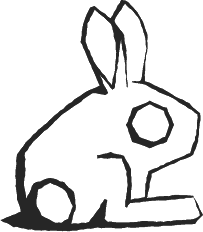Patricia Dutt
Whoever hung the plastic bag on Lucy’s doorknob didn’t even knock, as if he knew he was doing something wrong. The bag contained a single, color photograph of her front yard, a hillside wedge of goldenrod, Soldago canadensis, and knapweed, Centaurea nigra. A yard you might expect from a teacher of biology. In bold, twenty-five-point font lettering the notice stated: ‘You have violated the ten-inch rule.’ At first, Lucy imagined a feisty neighbor playing a joke on her. Hah, hah, reminiscent of Aerosmith’s, When I whip out my big ten inch. But, then she got another notice with the official town screed in small neat paragraphs on the cardstock’s back. Her neighbors unquestioningly followed the rules: there was not a blade of grass higher than three inches anywhere on their front lawns. Having a clear line of sight on a hilly road, in theory, prevented car accidents and reduced the opportunity for flattening of rabbits and pet cats. It was bad luck to run over a rabbit, and a tragedy to run over your pet cat. And ten inches was the law.
This edict shouldn’t have surprised Lucy. Some neighborhoods legislated acceptable house colors, or vehicle type — no rust buckets tolerated in the driveway despite any bad turn your life had taken, like your husband quitting his lucrative job, or your kid, having read too much Timothy Leary, deciding to drop out and tune in. Open minds can be dangerous. Leaving the radial arm saw uncovered in front of the garage, along with messily stacked two-by-fours, and sawdust blowing everywhere validated an individual determined to disseminate pandemonium.
A week later as Lucy ascended the hill to her house, she saw with escalating horror that someone had mowed her hillside wedge. She called the Town. The silence on the phone suggested an authority was listening, but all the authority did was repeat bureaucratic phrases that acknowledged no responsibility and dismissed consideration of other perspectives.
Lucy happened to be home the next time the sickle mower made its awkward way up the road, its industrial rattle dominating the soundscape. Flinging open her front door, she shouted and gestured until the operator turned down the mower’s engine, but not before he had mowed half the wedge. “Wildflowers and chaos have a purpose,” she said. “Don’t you know anything about ecosystems?”
That night at dinner she lamented to her husband and two teenage daughters the loss of safe havens and the death of large numbers of unaware insects.
“Lucy, it’s one wildflower garden,” her husband said. “They’re all over the yard.”
He didn’t get it. His engineer’s brain was hardwired toward the mechanical, neat-and-tidy end of the spectrum, not the free-flowing, organic, love Nature at any cost.
So, Lucy and her two daughters searched online and at garage sales for guardian gnomes. Following an appropriate and short, non-denominational blessing, they arranged the fist-sized gnomes in the wedge. Some they stuck on top of one-foot-long rebar, so that they wouldn’t be completely hidden by the knapweed or goldenrod.
At first neighbors didn’t know what to make of the squat, ugly creatures, but it was hard not to laugh, and because laughing was infectious, whimsical gnomes appeared on other lawns. The valley ridge road was prime walking territory — the vistas of the floodplain below, and hills to the east and south were breathtaking — and drew visiting pedestrians from all over the city. These visitors couldn’t help but laugh, too. And if that wasn’t enough, the steep hilly parts of lawns, and gullies, and the wet spots and dry spots, any weird places where you’d think a lawn would thrive, suddenly reverted back to Nature. Sometimes there was gnome protection, sometimes not.
Lucy’s lawn had been transformed into four-foot-wide pathways through swaths of clover, henbit, buttercup, comfrey, milkweed, and chicory. Before long, Lucy was handing out harvested seeds to passersby. Wildflowers popped up in lawns alongside her road, disrupting the green seas of concrete. Then other neighbors stopped mowing their lawns, leaving up hedges of honeysuckle, rosa rugosa, and buckthorn where songbirds nested. The morning symphony of birds was so loud and complex that it often masked the noise of traffic that rose from the valley floor.
⁂
One late afternoon, after a long day at the high school where Lucy worked, she looked out her front window and saw the code guy walking past her wildflower garden. The code officer, who lived two miles down the hill, now walked daily past Lucy’s house, not out of duty, she thought, but curiosity. He looked around, then tipped the brim of his Buffalo Bills’ baseball cap down, hiding his eyes, and in one swift movement deadheaded a ripe knapweed and snatched a gnome holding a pitchfork, discretely securing the prizes in his jeans pocket. He walked on, hands clasped behind his back, whistling.
Patricia’s short stories and flash fictions have been published in The Louisville Review, Deep Overstock, America Writers Review and other literary magazines. Her home is in central New York where she has taught high school science and worked as a landscape estimator. She writes a blog along with her son, Ben, called mentalchill.org.
